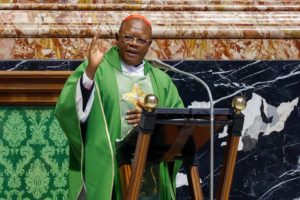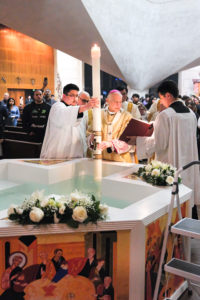Blind, unbridled consumerism and selfishness — not the number of people on the planet and having children — are the root causes of the world’s problems, Pope Francis said.
The reasons for pollution and world hunger, for example, are not based on the number of children being born, but on “the choices of those who think only of themselves, the delusion of unbridled, blind and rampant materialism, of a consumerism that, like an evil virus, erodes at the root the existence of people and society,” he said.
“Human life is not a problem, it is a gift,” he said. “The problem is not how many of us there are in the world, but what kind of world we are building.”
Pope Francis made his remarks at a meeting in Rome May 10 on Italy’s longtime decline in births and population growth.
The annual conference focuses on the general state of Italy’s birthrate and demographics and seeks to bring all sectors of society together to pursue concrete ways to reverse the country’s steeply declining birthrate. Sponsored by the Foundation for Natality and with the support of the Italian Forum of Family Associations and the city of Rome, the conference was held May 9-10 at a Rome auditorium not far from St. Peter’s Square.
Italy has had one of the lowest birthrates in the European Union for years. According to the Italian National Institute of Statistics, Italy continued to register less than 7 births per 1,000 people last year and saw 14,000 fewer births than in 2022. Italy’s fertility rate dropped to 1.2 in 2023 from 1.24 in 2022.
However, its population registered a decline of only 0.3% from last year due to increased migration and to fewer people leaving the country, the institute said.
Gianluigi De Palo, president of the Foundation for Natality, said in his talk before introducing the pope, that the group’s mission is to encourage Italy’s demographic winter to turn into springtime.
“Not because we are worried about who will pay for our pensions or who will support the national health care system, but because we want our children to be free” to choose what they want to do with their future, he said.
“It is not about convincing young people to have more children; it is not about convincing couples, families, women to have children,” he said.
The problem is that having children is one of the primary causes of poverty in Italy, “and this is unacceptable,” he said. People may feel free to not have children if they do not want them, but that freedom is denied to those who want to have children “but are not in a position to have them.”
Nothing concrete has been done, he continued, to actually enact or strengthen measures and policies that people agree with, such as more public child care centers and better parental leave.
In his talk, Pope Francis said the root cause of problems in the world “is not babies being born: it is selfishness, consumerism and individualism, which make people satiated, lonely and unhappy.”
“Selfishness makes one deaf to the voice of God, who loves first and teaches how to love, and to the voice of the brothers and sisters around us; it anesthetizes the heart,” making people live for things and possessions, losing the capacity to know “how to do good.”
Homes become “very sad places,” he said, emptied of children and “filled with objects,” dogs or cats.
The pope said what is needed are long-term approaches, effective policies and bold, concrete decisions so that what seeds are sown today, children “can reap tomorrow.”
“Serious and effective family-friendly choices” need to be made, he said. For example, women should never be put in a position where they have to choose between work and childcare, and young people should not carry the paralyzing burden of job insecurity and the inability to buy a home.
There should also be more intergenerational solidarity and generosity, the pope said.
Older generations should reassess their habits and lifestyles, “giving up what is superfluous in order to give the youngest hope for tomorrow” and, he said, younger generations should recognize and show gratitude for the sacrifices and hard work of those who helped them grow, he added.
In every discussion about birthrates and demographics, he said, do not forget to emphasize the importance of grandparents playing an active role in families.
It is “cultural suicide” to “discard” grandparents or let them live solitary lives, he said.
“The future is made by young and old together. Courage and memory together,” he said.
“These are the values to uphold, this is the culture to spread, if we are to have a tomorrow,” he said.
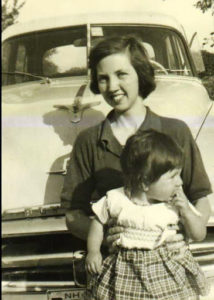
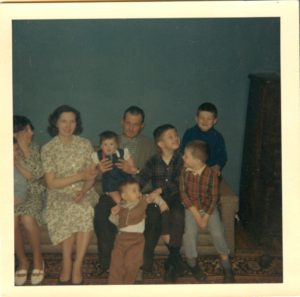
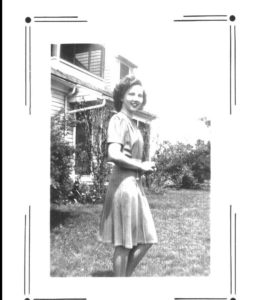
 Pascha and Bright Week: How to Meet and Spend the Feast so as Not to Negate the Labors of Great LentOn Pascha, a man removes the bridle from the horse of his body, and no longer holding back, rushes off somewhere. As a rule, the master of the horse, that is, the man himself, has no idea where the long-suppressed desire will take him. Fr. Andrei Chizhenko talks about what is important to remember during these days.
Pascha and Bright Week: How to Meet and Spend the Feast so as Not to Negate the Labors of Great LentOn Pascha, a man removes the bridle from the horse of his body, and no longer holding back, rushes off somewhere. As a rule, the master of the horse, that is, the man himself, has no idea where the long-suppressed desire will take him. Fr. Andrei Chizhenko talks about what is important to remember during these days.
 Bright Friday: The Life-Giving Spring of the TheotokosAfter Leo became Emperor as the Most-Holy Theotokos had prophesied he raised up a church over the spring, whose waters worked many healings and cured maladies by the grace of the Theotokos; from this, it came to be called the ”Life-giving Spring.” The Church of Christ celebrates the consecration of this church on this day.
Bright Friday: The Life-Giving Spring of the TheotokosAfter Leo became Emperor as the Most-Holy Theotokos had prophesied he raised up a church over the spring, whose waters worked many healings and cured maladies by the grace of the Theotokos; from this, it came to be called the ”Life-giving Spring.” The Church of Christ celebrates the consecration of this church on this day.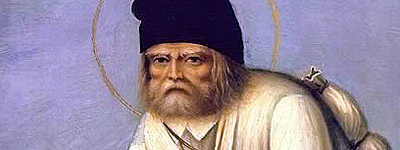 St. Seraphim of Sarov
St. Seraphim of Sarov
